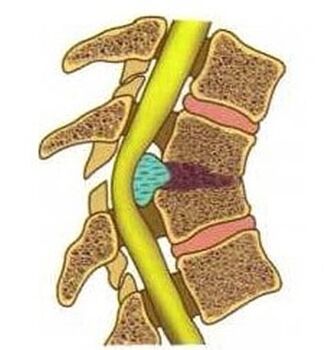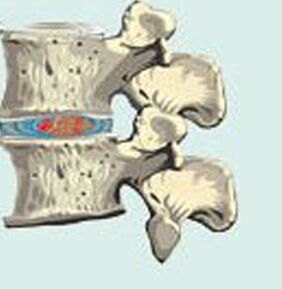Osteochondrosis is a degenerative-dystrophic vertebral disease in which the lesion of the intervertebral discs is determined in the form of their deformation, reduction in height and layer. The manifestations of this pathology are diverse, but can be combined into several syndromes. Depending on the severity of the symptoms, changes in the intervertebral discs surrounding their structures are differentiated several stages of osteochondrosis. Before treating osteochondrosis of the cervix region, it is important to find out why various drugs, physiotherapeutic and surgical methods are required.

General information
Osteochondrosis of the cervical spine most often develops in humans over 35 years, but sometimes their manifestations between the ages of 18 and 30 are observed. The cervical spine consists of vertebrae, the mobileest of them are usually affected-and 5. , 6. , 7.
There are intervertebral discs between the vertebrae, which represent a special form of the most durable cartilage bone connection. They offer the ability of the spine to withstand significant loads and mobility.
Each intervertebral disc consists of:
- Pulpoose (jacket) core that is a gel -like mass.
- Fibery poet ring that surrounds the core of the pane.
- Two thin plates made of white fibrous cartilage that cover the slices from top and bottom.
The intervertebral discs are connected to the bodies of the vertebrae to a band apparatus.
The causes of osteochondrosis
In people over 20 years, ships that feed between vertebral storms have overgrown. In the future, these structures will receive all the necessary substances through diffusion from a series of arranged vertebrae, but often these processes are not sufficient for normal metabolism in the windows.
Osteochondrosis of the cervical spine most often develops under the influence of:
- Hereditary disposition.
- Anatomical anomalies of the cervix region.
- Obesity.
- A sitting lifestyle associated with sedentary work, the lack of physical exertion.
- Trauma of the spine in the neck, including bruises, fractures.
- Metabolic disorders in the body.
- Age -related changes.
- Excessive physical exertion.
- Often psycho -emotional stress.
These factors exacerbate the diet of the intervertebral discs. As a result, the impulses are flattened, they become less elastic. The load of fibrous rings is increasing, which is accompanied by the stretch, the formation of cracks in them.
Against the background of such degenerative changes, the intervertebral disc can protrude to the spine canal. The irritation of the rear longitudinal band, which is rich in nerve endings, is accompanied by local pain.

As the disease progresses, a break of the rear longitudinal tape occurs, the intervertebral disc is emerged in the Cerebrospinal Canal, this condition is called hernia. At the same time, Rooster syndrome, caused by the irritation of the next cerebrospinal spine, is developing, local autoimmune inflammation. When the artery of radicular spinoe is pressed, the blood supply to the spinal cord is disrupted.
Osteochondrosis of the cervical spine is accompanied by the formation of osteofite - growth out of bone tissue on bodies, processes of vertebrae. These formations can also squeeze the roots of the spine or spinal cord.
The first characters
Osteochondrosis of the cervical-Thoraic department in the initial phase is accompanied by tensions and a quick tiredness of the muscles of this area. Then there are symptoms, pain in the nose, neck, shoulders that tighten during the tendencies, the turns of the head are connected.
Dizziness, headache - another first sign of cervical osteochondrosis in women, men. Sometimes a person experiences pain, a feeling of deafness that ties in his hands after sleep.
The main symptoms
Osteochondrosis of the cervical spine is most frequently through:
- radicular syndrome;
- Syndrome of the arteries of vertebrae;
- Cardiological syndrome.
Some people have reflex -dystrophic syndromes, disogenous cervical myelopathy. Disruptions in the emotional area, panic attacks with cervical osteochondrosis are often also determined.
Rook syndrome
The manifestations of the radicular syndrome are caused by compression (compression) the root of the vertebral nerves of the hernia of the intervertebral discs, the osteophytes of the body, the processes of the vertebrae itself. As a result of the compression of the nerve fibers, a local inflammatory reaction arises, which is accompanied by pain by the cold of the nerve affected.

Therefore, symptoms such as pain in the neck, hands and areas of the back occur. Unpleasant sensations can be determined in the heart, in the stomach. If the neck pain stays constantly, reinforced when turning and the head tends, this condition is called cervicalgia. In addition, the pain can have the character of Lumbago, in the hand, they are referred to as service.
In those areas that inner nerve, there is a pronounced reduction in sensitivity. The muscles in this area become weaker, their atrophy can be observed, which is accompanied by a decrease in their volume.
Vail arteries syndrome
The vertebral artery is a paired blood vessel that supplies the brain by 15 to 30%blood. If you press the vertebral artery, various chronic manifestations of oxygen insufficiency in the central nervous system are determined by the changed intervertebral discs of the vertebrae.
In the development of this state, 2 stadiums are differentiated: functional, organic (ischemic). In the first of them, the main symptoms of syndrome of vertebral artery with cervical osteochondrosis are common headaches. They become more pronounced in the movements of the head and hold a position for a long time. The pain painful or pulsating and felt in the occipital, temporal frontal areas.
Dizziness for cervical osteochondrosis is also characteristic of the functional stage of this syndrome. Its intensity is different: from a feeling of instability to a sudden fall or a fast rotation of the body. Sometimes the hearing is reduced, a person can be disturbed by the noise in the ears. Visual disorders are found in the form of flies that flash in front of the eyes.
With the progress of the pathology, the ischemic stage occurs. It is characterized by temporary brain circuit disorders in the form of temporary ischemic attacks, the occurrence of which is often provoked by a quick inclination or rotation of the head.
Several options for the syndrome of vertebral artery are differentiated, with cervical osteochondrosis, the manifestations of which have their own properties:
- Drop Attack.
- Barre-Lieou syndrome (rear-cervical syndrome, cervix migraine).
- Basic migraine.
- Syncopa vortex syndrome.
- Ophthalmic syndrome.
- Vegetative dysfunction syndrome.
- Ophthalmic syndrome.
- Kohleo Invest Bulary Syndrome.
- Temporary ischemic attacks.
In the event of a drop attack, one person suddenly falls, throws back the head, cannot move. Losses of consciousness are not observed to move independently after a few minutes. This condition is caused by the inadequate blood flow to the cerebellum, the brain strain.
The Cervical migraine syndrome occurs due to the compression of the alternating interpretations or osteophytes of nervous plexus that surround the vertebral arteries. This condition is characterized by stupid headaches that regularly become pulsating. They usually arise if, for example, you have to maintain a forced position of the head for a long time. This often happens on an unpleasant pillow after sleep when you work on the computer. Such a headache for osteochondrosis of the cervix region becomes stronger when descending, climbing the stairs, trembling when driving in transport and walking quickly. The pain is on the one hand in the background area that apply to the front parts of the head. You can stay from a few minutes to hours.

Manifestations of the Syncopa vortex syndrome occur due to insufficient oxygen intake on the reticular formation of the brain. This condition is accompanied by a short -term fainting, with a long head stay, neck in a forced position.
The symptoms of cervical osteochondrosis in women, men in the form of pain, the feeling of sand in their eyes, sparks in front of them are some of the manifestations of a ophthalmic syndrome. It is a decrease in visual acuity, which is more pronounced on the eyes with increased stress. A partial loss of the field of visual fields is possible. The closure occurs, the reddening of the conjunctiva is noticeable.
The attack of the basic migraine begins with a decrease in eyesight of both eyes, noise in the ears, a disturbed passage, the lubrication of the language. Dizziness with cervical osteochondrosis of this variant of the course is also found. Then there is severe headache in the Occipital region, accompanied by vomiting, the attack ends with a loss of consciousness.
With the development of a cochleo-investing syndrome, if the pathological process of vertebral artery incorporates into the ears, a person notes a decrease in hearing and a perception of the whispering is particularly difficult. The feeling of the instability of her body in the room, a feeling of rotation of the nearby objects.
The vegetative dysfunction syndrome reflects disorders in the work of the autonomous nervous system, in response to squeezing the vertebral artery, nerve fibers that are around them. It is characterized by a feeling of heat, a increased sweating. The feet, palms become cold, by touching wet and sewing pain in the heart. The vegetative symptoms of cervical osteochondrosis in men, women usually accompany the manifestations of other syndromes.
Sub -level ischemic attacks suddenly create attacks on impaired coordination of movements, severe dizziness, language impairment, nausea and vomiting. If a person takes a horizontal position, these manifestations are usually reduced. After such an attack, headache, weakness, flies, flashes in front of the eyes, noises in your ears are preserved for a while.
Sometimes blood pressure increases with cervical osteochondrosis, which is also a consequence of the pressing of the vertebral artery. As a result, the area of the brain, which is responsible for regulating the pressure, lacks oxygen. The same nervous impulses arise, as with reduced blood pressure, under which it increases strongly.
Development stages of osteochondrosis
Since degenerative-dystrophic changes in the intervertebral discs develop, osteochondrosis runs several stages in its development.
Osteochondrosis of the 1st degree of the cervix region (preclinical stage)
Osteochondrosis of the cervical-Thoraic department at this stage is accompanied by muscle tension and complaints. There is a slight smoothness of the cervix lordosis (physiological bend of the spine in the form of its bay to the front). Sometimes pain occurs in this area, a temporary decrease in sensitivity in the collar zone.
Osteochondrosis 2 degrees
There is a feeling of weakness in the hands, the deafness of the skin of the face, the neck, also the sensitivity in the upper limbs. Eyesight deteriorates, noise in the ears has been determined.
Osteochondrosis 3 degrees
At this point there is a break of the intervertebral disc with or without education. The pain in the neck, the collar zone becomes more pronounced, more permanent, is put in your hands.

Osteochondrosis 4 degrees
In the case of osteochondrosis of the cervical spine, blood vessels are not only involved in intervertebral slices, vertebrae, but also nerve fibers in the pathological process, sometimes the spinal cord, the muscles, the joints of the upper half of the body are affected. The symptoms of the disease are diverse, similar to signs of other pathological diseases. If the manifestations of osteochondrosis occur, you must immediately consult a doctor to undergo an exam.
First aid with severe pain
The treatment of osteochondrosis of the cervical spine in the event of severe pain should first aim to stop it. Drugs with painkillers are used for this. They are taken inside to achieve a faster effect with cervical osteochondrosis. Injections of the solutions of these medicines are recommended.
Sometimes a pepper patch is used, this tool stimulates the skin receptors and improves blood circulation in the application zone. As a result of such a distracting effect, the experienced pain seem to be less pronounced.
Physiotherapy
The treatment of cervical osteochondrosis in women, men with physiotherapy are based on:
- Elimination of pain;
- Reduction of inflammation;
- Relaxation of the convulsive muscles;
- Improvement of metabolic processes, blood supply in the affected area;
- The release of roots of spinal nerves, which were injured with osteophytes (bone growth on the vertebrae).
The massage begins with the stroking the collar zone towards the spine up to supraklavicular armpit zone in areas. Then the bruises are carried out because the masseur puts its hand with an edge perpendicular to the spine, moves it from top to bottom. In the future, rubbing will be used to heat the muscles to improve local blood flow. The fingers are carried out by lively, circular movements that are started from the base of the skull. In a circular movement, the muscles in the area of the collar area are smeared. In order to complete the massage, vibration movements are used in the form of concussion and caresses.




















